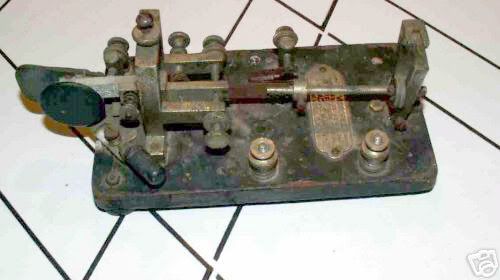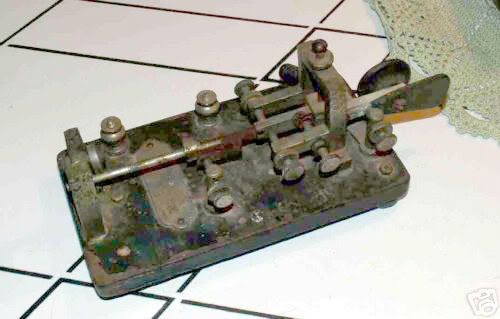The earliest Vibroplex I've been able to afford on eBay was a very well-worn 1913 Original that had seen tremendous use. But through some sniping techniques, I was able to snag the well-used but in fairly good shape 1912 Original pictured at right.
The price on this key was right, which was the only reason I pursued it. Keys manufactured in the 1920s and before usually attract the attention of collectors, and the winning bids usually reflect that.

In the case of this key, bidding had stalled at less than $50 until the day before the auction ended. It was only as the auction end neared that it hit the $100 mark. Four people put in bids on the key within the final seconds. My bid barely got in on the final second before the auction closed — not a testament to my skill, but to the fact my clock was a couple of seconds off.
The secret to successful sniping is to get a high enough bid in at the last minute. I've got the “last minute” part down, but I don't always bid high enough. In the case of this key, I bid my top price, and I was pleasantly surprised to find out that I won.
The key arrived in yesterday's mail, and I finally got it out for a good look see tonight. The photos don't do the key justice. It's an interesting key because at this time the serial number was stamped on the damper and not engraved on the ID plate. This key dates from the period before company founder Horace G. Martin partnered with J.E. Albright to form the Vibroplex Co.
The seller got it from his brother, and according to the listing, the key belonged to his brother's father-in-law, who collected all sorts of “stuff.” The key has been somewhere for a very long time and not used.
Several adjustment screws are frozen in place, I haven't tried to free them, but expect a little penetrating oil will fix that. The base still has the original finish, and the original gold carriage striping is still partly visible. The photos really don't do the key justice.

The key is a really nice addition to my collection. It is an example of the key's evolution from handmade telegraph instrument into something more refined and produced in increasingly greater numbers.
Many Vibroplex collectors consider keys from about this point back to 1904 as a seperate model that stands apart from later versions of the key. The early keys had some obvious differences, which on mine include a unique damper design which has an adjustment screw; screws that attach the feet go completely through the base and terminate on the top side with nuts, and the finish of the way the edges of the base are finished and machined.
Inventor Horace Martin eliminated the adjustable damper, realizing it was not a feature that was necessary. The screws that attach the feet were designed so that did not pass completely through the base. The base was cast and machines with a different process that chamfered the corners and edges.
All in all, its an interesting bit of history to ponder … or perhaps just minutia that's the result of way too much time on the Internet!
SPEAKING OF VIBROPLEX – KINDA …
A key that arrived in Saturday's mail was one that doesn't come up often on eBay.
This key isn't a Vibroplex design; its a version of the original J.A. Hills FYO keyer developed in the early 1960s and licensed by the Bencher company as their popular and long-running BY-1 and BY-2 Bencher paddles.
This key is usually mistaken by its more common version, the Vibroplex Brass Racer. The key I am referring to is the predecessor of the Brass Racer, a key called The Scotia that was manufactured by Hamco.
From 1978-1982, Hamco offered three version of its wood-and-brass-based triangular-shaped iambic paddle.
The Scotia – Nearly identical to the Brass Racer sold today. The difference is that the magnets are held in place with set screws on The Scotia. Vibroplex omitted the set screws, which means the assembly can fly apart if you accidently pull the magnet from the upright brass housing. The brass base of the key — like the Brass Racer — has a satin finish.
The Trinidad – This version of the key features an engine-turned finish on the key's triangular brass base plate.
The Carson – The brass base of The Carson is hand polished to a bright, mirror finish.
The Scotia is by far the most common key you'll see of the three Hamco models. Vibroplex bought the rights to the key in 1982, and dropped the Trinidad and Carson versions.
Vibroplex pioneered the iambic keyer with the built-in Curtis keyer chip — the model EK-1– which was all the rage for CW keyers. The keyer used a battery that is no longer available, but Vibroplex does have instructions for converting it to a regular Brass Racer.
My Scotia that arrived yesterday has an excellent feel to it. I'm not use exactly why yet but it has a much better feel than my Vibroplex Brass Racer. The difference must be the adjustments as there's not much difference between the two.
The Scotia is in excellent condition, and is serial number 1461. Needless to say, Vibroplex has produced many times that many Brass Racers. I've considered selling the Brass Racer just because its not exactly the type of key I collect; I bought it because I have never owned one and wanted to try it. Before sending it on its way to the eBay food chain, I probably should spend some time using it first. I would really like to use the Brass Racer and Scotia side-by-side just to see how they compare.
That's all the news that's fit to print from my shack. There's a hamfest coming up next Saturday, so I'll have my official SM hat on for that.
73 es GN … de KY4Z … dit dit …
